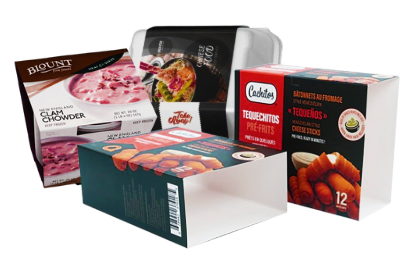Whether you’re presenting pastries or frozen meals, Custom Food Packaging Sleeves bring a distinct touch of personality and practicality. These sleeves serve more than just aesthetic purposes; they help reinforce branding while ensuring proper coverage. For small businesses and large food brands alike, sleeve packaging offers a flexible and efficient wrapping solution. In this article, we’ll explore the materials used in designing these sleeves, their properties, and why they’re essential for safe food handling. As demand grows for more sustainable packaging, understanding what goes into these sleeves becomes crucial for businesses looking to make informed packaging decisions. Food Sleeve Packaging has emerged as a sustainable and visually appealing solution for branding and protecting edible products.
Common Materials Used in Custom Food Packaging Sleeves
Cardboard and kraft paper are two of the most popular materials used in designing Custom Food Packaging Sleeves due to their eco-friendly properties and structural integrity. Both materials support custom printing, making them ideal for showcasing branding elements, nutritional facts, and usage instructions. Their versatility enables them to wrap various types of food containers, such as trays, bowls, or cups, while also being recyclable and compostable.
Unlike plastic-based wraps, these paper-based sleeves resist grease when coated and hold up well under different temperatures. Additionally, laminated paperboard is often used for added strength and smooth texture, particularly for frozen and refrigerated items. Combining aesthetics with function, these materials give businesses an efficient packaging choice while supporting environmental responsibility.
Biodegradable Options and Eco-Friendly Appeal
Alternatives to traditional packaging have steadily gained ground, and eco-conscious businesses now opt for biodegradable sleeve materials. Recycled paperboard, plant-based fibers, and compostable kraft are front-runners in this category. While they break down faster in landfills, they also maintain enough sturdiness to support food items.
Moreover, these materials are not only safe but also reduce waste significantly. Coatings made from water-based or soy-based inks are often used to print vibrant graphics without harming the environment. With growing environmental concerns, biodegradable materials offer a smart packaging solution. They also satisfy modern consumer demands for green practices, making them a strategic addition to any packaging line.
Coated Finishes and Their Specific Benefits
Durability meets design through the use of coated surfaces in food sleeve production. Coatings such as gloss, matte, or aqueous finishes help protect the material from moisture, oil, and tearing. These coatings also bring out visual brilliance, ensuring that branding stands out on shelves.
Coatings improve visual appeal and functionality. Matte coatings, for example, offer a smooth, glare-free look and provide better writing surfaces, useful for labels or expiry dates. On the other hand, gloss coatings resist smudges and fingerprints, making them suitable for high-touch products. Aqueous coatings, being water-based, are safer and more sustainable while offering decent resistance. For businesses aiming for attractive yet practical packaging, coated finishes deliver on both fronts.
Different Types of Custom Food Packaging Sleeves
Not all sleeves are made the same. Depending on the product, design intent, and required protection, packaging sleeves come in a variety of types.
- Printed Paper Sleeves
- These are commonly used for dry snacks, sandwiches, or pre-packed bakery items. They offer excellent print clarity and are often made from FSC-certified paperboard.
- Kraft Sleeves
- Preferred for their rustic appearance and biodegradable nature, kraft sleeves work well for eco-conscious brands that want a natural look without compromising durability.
- Die-Cut Sleeves
- These offer a window or cut-out area to show off the product inside. While aesthetically pleasing, they are also useful in helping consumers identify the food item quickly.
- Sleeves with Inserts
These sleeves include additional internal supports, useful for fragile items like cupcakes or chocolate truffles.
Each of these types serves distinct marketing and functional needs, giving flexibility across different food categories.
Although simple in form, these sleeves carry immense value for both branding and sustainability goals. Their efficient design enables smooth assembly while saving time and material.
“Packaging can be theater, it can create a story.”
Factors Influencing Material Selection
Every packaging solution is influenced by product nature, storage conditions, and branding requirements. Edible products that require refrigeration will benefit more from moisture-resistant materials like laminated board. On the contrary, dry goods work well with simple kraft or uncoated paperboard.
Besides functional needs, the choice also depends on visual elements. High-end dessert brands often prefer sleek, glossy finishes to highlight luxury, whereas organic snack companies lean toward recycled kraft. Storage and transport also play a part; sturdier sleeves prevent bending and spillage during movement. Therefore, the right material depends on striking a balance between safety, aesthetics, and sustainability.
Key Features, Usage, and Advantages
Below are some important factors associated with the use of food packaging sleeves, especially those designed with precision and eco-sensitivity:
- Usage – Applied over containers like trays, cups, or boxes to secure, brand, and protect food products.
- Benefits – Include easy recyclability, print customization, and reduction in plastic usage.
- Features – Lightweight structure, printable surfaces, various finish options, and temperature resistance.
- Application – Widely adopted in cafes, bakeries, meal-prep services, and supermarkets for labeling and product presentation.
Role of UK Packaging Companies in the Sleeve Market
Globally, the demand for food-safe and eco-conscious packaging is on the rise, and UK Packaging Companies are actively contributing to this shift. Many of them are now investing in advanced printing technologies and biodegradable innovations to support modern packaging needs. These companies are also ensuring compliance with food safety regulations, giving businesses peace of mind when selecting suppliers.
From sourcing FSC-certified materials to offering recyclable coatings, companies in the UK are at the forefront of sustainable packaging evolution. Their wide variety of services helps restaurants, cafes, and food brands customize sleeve solutions that reflect their identity while maintaining quality standards.
Conclusion
Understanding what goes into Custom Food Packaging Sleeves helps food businesses make smarter, more sustainable packaging choices. From biodegradable kraft to coated cardboard, each material offers unique benefits aligned with product safety and branding goals. These sleeves serve not only as protective layers but also as silent marketers of your product’s quality and identity. As industries move toward greener solutions, these versatile packaging options stand out. With innovative efforts from UK Packaging Companies, the packaging landscape continues to shift in a more responsible and appealing direction, where both function and design walk hand in hand.

